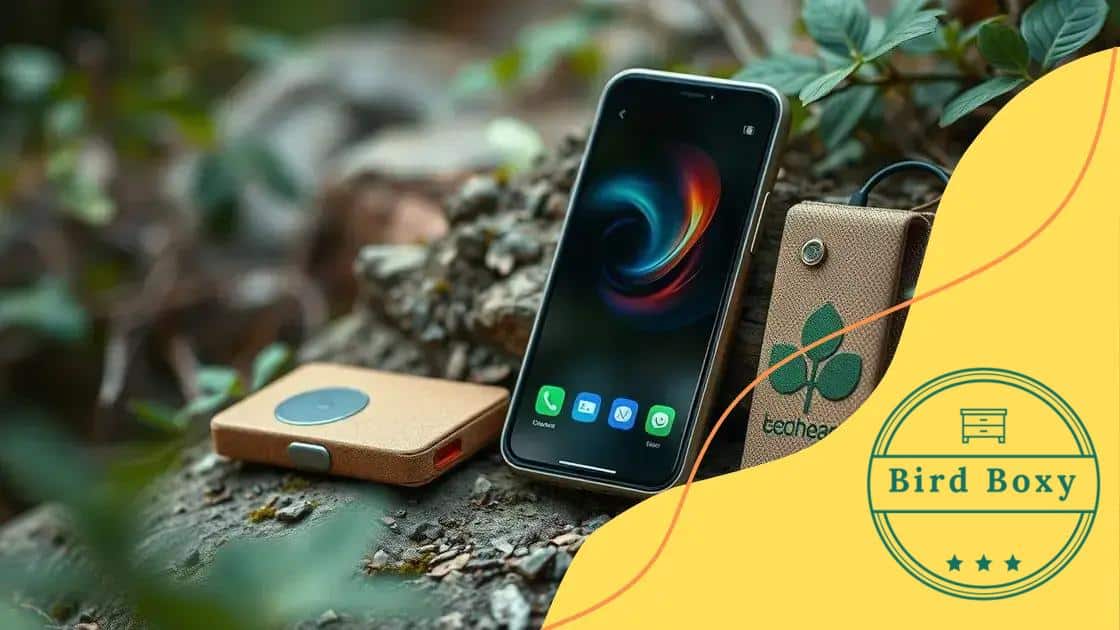Biodegradable tech devices trends shaping the future

Biodegradable tech devices are sustainable electronics designed to break down naturally, significantly reducing electronic waste and promoting environmentally friendly practices in the technology sector.
Biodegradable tech devices trends are not just buzzwords anymore; they represent a movement toward sustainable technology. Ever wondered how these innovations could reshape our tech landscape? Let’s dive into the exciting developments ahead.
Understanding biodegradable technology
Understanding biodegradable technology is essential as we look for solutions to reduce electronic waste. Biodegradable tech devices offer a fresh approach to sustainability in the world of gadgets. They are designed to break down naturally, leaving minimal impact on the environment.
By focusing on these innovative materials, we can help combat the growing concern over waste management in technology. Biodegradable devices often use natural substances, which makes them a great alternative to traditional plastic components.
Key Components of Biodegradable Technology
Several materials and methods make biodegradable technology possible. These components ensure that tech devices can function effectively while being environmentally friendly.
- PLA (Polylactic Acid): Derived from corn starch, it’s commonly used in 3D printing and packaging.
- PHA (Polyhydroxyalkanoates): A type of plastic made from microbial fermentation of sugars or lipids, it decomposes in natural environments.
- Natural Fibers: Materials like hemp or bamboo are used to create durable yet biodegradable casings.
- Biodegradable Electronics: Innovations in circuit boards and conductive inks make entire devices compostable.
Many companies are exploring ways to create biodegradable products without compromising on performance. For instance, some brands are experimenting with coatings that allow devices to be composted at the end of their life cycle. This not only helps reduce waste but also provides eco-conscious consumers with choices that align with their values.
Moreover, the use of biodegradable technology minimizes the need for harmful chemicals that can leach into the earth. This technology has the potential to change our relationship with devices, encouraging companies and consumers alike to prioritize the planet. By understanding the benefits and applications of these materials, we can pave the way for a greener future.
Key players in biodegradable device manufacturing
When exploring key players in biodegradable device manufacturing, it’s important to recognize the companies that are leading the charge towards more sustainable tech solutions. These innovators are committed to reducing environmental harm while advancing technology.
Some of the most notable brands are pioneering designs and materials that make biodegradable devices viable. For instance, companies like Apple and Samsung are investing in research to incorporate biodegradable components into their products. This shift aims to address growing consumer concerns regarding electronics waste.
Innovative Companies in the Field
Beyond the tech giants, numerous startups are emerging in the biodegradable device sector, pushing the boundaries of what is possible. Here are some of the most promising:
- Fairphone: Known for its ethical approach, Fairphone is looking into biodegradable elements to create eco-friendly smartphones.
- BioLogiQ: This company produces biodegradable resins used for manufacturing various tech components.
- Haier: Investing in biodegradable materials, Haier aims to integrate these substances into home appliances.
- WAVE: A startup that focuses on sustainable electronics, producing devices that are both sleek and environmentally friendly.
The developments by these companies illustrate a significant shift in manufacturing practices. By using biodegradable materials, they aim to minimize the carbon footprint of tech devices. This transition is not only beneficial for the environment; it also captures the interest of consumers who prioritize sustainability in their purchases.
This evolving landscape creates opportunities for collaboration and innovation within the industry. As these key players adapt and grow, the advancement of biodegradable technology will likely influence mainstream electronics in the coming years. Their efforts highlight the importance of moving towards more responsible manufacturing practices while meeting consumer demand for eco-friendly options.
Recent advancements in biodegradable materials

Recent advancements in biodegradable materials have paved the way for significant improvements in sustainable technology. Many researchers and companies are actively working on developing materials that can break down naturally, thus reducing plastic pollution and electronic waste.
New innovations have emerged in this field, enabling the production of biodegradable alternatives for commonly used materials. For instance, scientists are exploring the use of mycelium, a natural fungal network, to create sustainable packaging and components. This development showcases how nature can offer solutions to our modern challenges.
Breakthrough Materials
Some of the most exciting advancements include:
- Compostable Plastics: Made from renewable resources, these plastics can completely decompose in industrial composting facilities.
- Biodegradable Electronics: Researchers are developing electronic components that can decompose after their useful life, reducing e-waste significantly.
- Natural Fiber Composites: Combining fibers from plants like hemp or bamboo with bioplastics leads to materials that are both strong and eco-friendly.
- Algae-based Materials: Some companies are creating packaging and products from algae, which can grow rapidly and is biodegradable.
These materials not only help lessen environmental impact but also show great potential in various industries. For example, biodegradable electronics can revolutionize how we view product disposability and sustainability. Understanding these advancements allows consumers and manufacturers alike to make better choices for the planet.
As these technologies progress, they are becoming more accessible to manufacturers, enabling even wider adoption in the industry. Innovations in biodegradable materials will likely influence the future design and manufacturing of tech devices. With a growing awareness of eco-friendly alternatives, more brands are expected to embrace these sustainable materials.
Environmental impact of biodegradable tech
The environmental impact of biodegradable tech is a significant topic in today’s conversation about sustainability. As technology continues to evolve, understanding how biodegradable devices can help reduce waste is essential.
Unlike traditional electronic devices that often contribute to landfill overflow, biodegradable tech devices are designed to break down naturally. This can lead to a decrease in the amount of harmful waste that pollutes our ecosystems. For instance, when these devices reach the end of their lifecycle, they can decompose, returning nutrients to the soil rather than releasing toxic chemicals.
Benefits of Biodegradable Tech
Several benefits of biodegradable tech can positively influence the environment:
- Reduction of Electronic Waste: By replacing conventional materials, biodegradable tech can significantly lower the overall electronic waste produced.
- Lower Carbon Footprint: The production of biodegradable materials often involves fewer emissions than plastic manufacturing.
- Improved Soil Health: As biodegradable devices break down, they enrich the soil rather than harm it, supporting plant growth.
- Minimized Resource Depletion: Using renewable resources for production helps conserve non-renewable materials.
Moreover, using biodegradable materials can encourage consumers to embrace more sustainable technology choices. As awareness grows about the positive impacts of these products, it’s likely that more companies will invest in their development. In turn, this could lead to wider acceptance and demand for biodegradable options across different sectors.
Furthermore, the shift toward biodegradable technology signifies a change in consumer habits. People today are more aware of the environmental repercussions of their purchases. Thus, choosing biodegradable tech not only reflects a desire for better technology but also a commitment to protecting the planet. This evolving market is an exciting opportunity for both manufacturers and consumers to collaborate for a sustainable future.
Future predictions for biodegradable devices
Future predictions for biodegradable devices indicate exciting developments in sustainable technology. As awareness about environmental issues grows, manufacturers are expected to prioritize creating products that are not only effective but also eco-friendly.
Advancements in material science are likely to lead to the creation of even more efficient biodegradable components. Researchers are currently exploring innovative substances that could replace traditional plastics in tech products. For example, sustainable materials like plant-based bioplastics and organic composites are on the rise. They not only reduce environmental impact but are also cost-effective in longer production runs.
Trends to Watch
Several key trends in the future of biodegradable devices may shape the market:
- Enhanced Durability: Future devices will likely focus on improving the durability of biodegradable materials, making them suitable for a wider range of applications.
- Smart Materials: Integration of smart technology with biodegradable materials could allow devices to adapt and improve user experience while remaining eco-friendly.
- Wider Acceptance: As more consumers demand sustainable options, companies will be encouraged to adopt biodegradable designs in their product lines.
- Legislative Support: Potential regulations favoring sustainable practices may drive innovation and investment in biodegradable technologies.
As these changes take place, a shift in consumer behavior is expected. People are becoming more conscious of their purchases and gravitating towards brands that prioritize sustainability. With this demand, the race to produce biodegradable tech products will intensify. This implies that future products will not only be more environmentally friendly but also meet rising consumer expectations for quality and performance.
The collaboration between tech companies and environmental scientists will be crucial in this transformation. By working together, they can develop pioneering solutions that address both performance needs and ecological responsibilities. Therefore, the future looks bright for biodegradable devices as they pave the way for a healthier planet.
FAQ – Frequently Asked Questions about Biodegradable Tech Devices
What are biodegradable tech devices?
Biodegradable tech devices are electronic products designed to break down naturally after their useful life, minimizing environmental impact.
How do biodegradable materials help the environment?
They help reduce electronic waste by decomposing instead of contributing to landfills, thus lowering pollution and enriching the soil.
What innovations are being made in biodegradable tech?
Recent innovations include the use of plant-based bioplastics, mycelium, and organic composites to create more sustainable electronics.
Why should consumers choose biodegradable tech products?
Consumers should choose biodegradable tech products to support sustainability efforts, reduce waste, and promote healthier choices for the planet.






